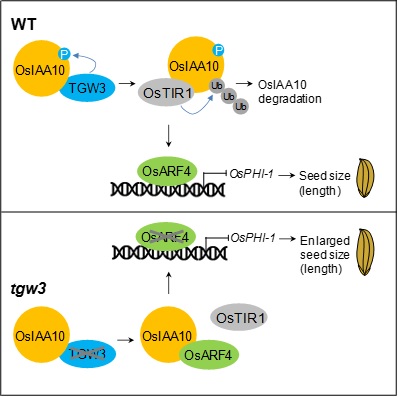
In a study published in Cell Reports, Prof. SONG Xianjun's group from the Institute of Botany of the Chinese Academy of Sciences has uncovered a gene network underlying the regulation of seed size.
The researchers found that a genetically defined cascade—OsTIR1–OsIAA10–OsARF4—plays an important role in controlling rice grain size, and Thousand-grain weight on chromosome 3 (TGW3) phosphorylation of OsIAA10 regulates the trait by altering the corresponding auxin signaling.
Cultivated rice (Oryza sativa L.) is an important crop, feeding more than half the world’s population. In rice, grain size is an important agronomic trait that significantly affects grain yield and quality. However, few genetically defined pathways for grain size control have been reported so far.
Together with other groups, the researchers reported in 2018 a large QTL for grain size and yield, called TGW3, whose target gene encodes a GSK3-like protein kinase. They then identified the canonical auxin/indole-3-acetic acid protein OsIAA10 as a novel interacting partner of TGW3. As expected, TGW3 has the ability to phosphorylate OsIAA10.
Interestingly, in this study, the researchers identified three serine sites—Ser68, Ser75, and Ser97—of OsIAA10 as the major amino acids that are phosphorylated by TGW3 and found that the phosphorylation of OsIAA10 is involved in grain size regulation.
In addition, they showed that TGW3 phosphorylation of OsIAA10 promotes ubiquitylation and proteolysis of the substrate. Mechanistically, phosphorylation of OsIAA10 favors its interaction with OsTIR1 but hinders its association with OsARF4.
Furthermore, genetic evidence indicated that a viable OsTIR1–OsIAA10–OsARF4 auxin signaling axis regulates rice grain size.
"TGW3 may mediate the brassinosteroid (BR) response and the physiological effect may be transmitted through the regulatory pathway," said Dr. MA Ming, first author of the study.
Overall, these findings uncover a phosphorylation-driven auxin signaling pathway for seed size regulation in rice, providing useful information for the improvement of the agronomic trait in crops.

Phosphorylation of OsIAA10 caused by TGW3 shapes rice grain size through alteration of the auxin signaling regulatory module OsTIR1-OsIAA10-OsARF4. (Image By IBCAS)

86-10-68597521 (day)
86-10-68597289 (night)

52 Sanlihe Rd., Xicheng District,
Beijing, China (100864)

